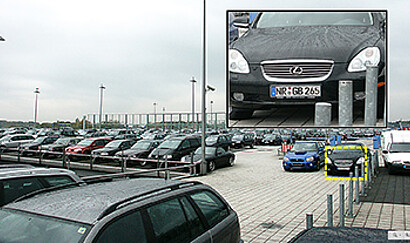Skills
Image resolution and formats
septiembre 17, 2019
The ratio of the number of horizontal lines to vertical columns determines the aspect ratio. In this example it is 16:9.
An overview of common image formats:
Resolution/aspect ratio | Name | Megapixels |
640 x 480 / 4:3 | VGA | 0.3 |
768 x 576 / 4:3 | PAL-D | 0.4 |
1024 x 768 / 4:3 | XGA | 0.8 |
1280 x 720p / 16:9 | HD (ready) | 0.9 |
1280 x 960 / 4:3 | SXVGA | 1.2 |
1600 x 1200 / 4:3 | UXGA | 1.9 |
1920 x 1080p / 16:9 | Full HD | 2.1 |
2048 x 1536 / 4:3 | QXGA | 3.1 |
3840 x 2160 / 16:9 | Ultra HD / 4K UHD | 8.3 |
The image resolution of a camera uni
The maximum image resolution that a camera unit can provide depends on the imaging chip and the lens. Both of these components must be capable of handling the required resolution in order to achieve the best possible image quality for a camera.
Our advice:In practice, people often try to save with the lens – an unfortunate decision. A mediocre camera with a high-quality lens will in general provide better picture quality than a top-of-the-line camera with a cheap lens.
HD ready, Full HD, Ultra HD – what are the advantages of higher resolutions and what do they "cost"?
Consumer electronics lead the way and video security plays catch up: Ever higher image resolutions become the new standard. The sales argument: A completely new, impressively brilliant viewing experience. The benefits for video security appear to be clear: More details in an image either mean that fewer cameras can be used per monitoring scene or more information is available for image analysis.
But as is so often the case, the technically feasible is not always the same as the optimal solution. The use of cameras with higher resolution has some additional consequences. From lighting to bandwidth to storage capacity to playback performance – a large number of factors must be taken into account when deciding which resolution is right for the job:
Fields of application
More details per camera
The more dots (pixels) used to depict a scene, the more details will be visible. With identical camera position and viewing angle, more detail can be recognized, in particular when zooming in. This is one of the reasons to use high-resolution cameras.
Larger surveillance area with fewer cameras
On the other hand, with one individual camera with a wide-angle lens, a larger scene can be recorded at the same level of detail. This makes it possible to replace multiple low-resolution cameras with one high-resolution camera. This saves costs not just for the cameras, but also for the installation and wiring.
No benefits without a price
Light sensitivity and lighting
Compared to low-resolution cameras (with the same size and technology of the imaging chip), high-resolution cameras are less sensitive to light, meaning they require more light to produce a clear, noise-free image. This is a simple matter of physics. For the same size imaging chip, as the resolution increases so does the number of pixels on the surface of the imaging chip, meaning that the surface area of each individual pixel becomes smaller. This in turn reduces the amount of light that is recorded by each pixel.
Our advice:It is best to perform tests around the clock to determine whether the camera provides the details you need with the existing lighting. Also pay attention to the level of detail in moving pictures. Low light sensitivity is often compensated for by longer exposure time. This leads to motion blur, which unfortunately makes the most relevant part of the image unrecognizable: for example a quickly moving intruder.
Stream size and further processing
More details per image also simply means more data. This means that higher-resolution cameras also automatically provide image streams (streams) at higher data rates. These naturally require more network bandwidth, more capacity in the storage system and even more computing power for the playback stations. The entire system must be designed for these larger data streams.
Our advice:Many modern cameras offer "multi-streaming", meaning a camera can generate multiple streams with different resolutions and frame rates. A stream at a lower resolution is often sufficient for the live image or for documentation, it may be possible to record at a lower frame rate.
Another thing: Our systems are not only able to process various streams. Our Adaptive Stream Management also ensures that the streams are automatically generated and provided as the system and the operator need at that moment.
An example: In a multiple-image display with, for example, 16 viewer windows, the system provides each stream in low resolution. When the operator activates the display of one camera in full-screen mode to see more detail, the system then provides this stream at a higher resolution, switching off the other streams completely.
Back


